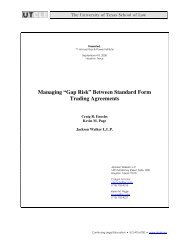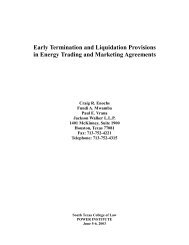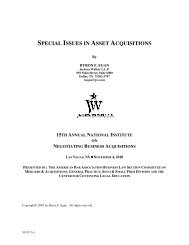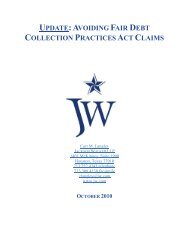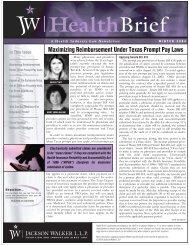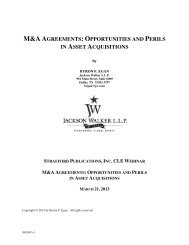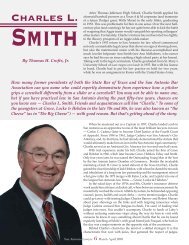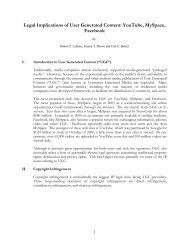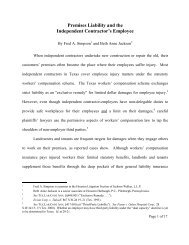asset acquisitions - Jackson Walker LLP
asset acquisitions - Jackson Walker LLP
asset acquisitions - Jackson Walker LLP
Create successful ePaper yourself
Turn your PDF publications into a flip-book with our unique Google optimized e-Paper software.
North Dakota, and Delaware require that reference to the negligence or fault of theindemnitee be set forth within the contract. See Gross v. Sweet, 458 N.Y.S.2d 162(1983)(holding that the language of the indemnity must plainly and precisely indicate thatthe limitation of liability extends to negligence or fault of the indemnitee); Schlobohn v. SpaPetite, Inc., 326 N.W.2d 920, 923 (Minn. 1982)(holding that indemnity is enforceable where“negligence” is expressly stated); Alack v. Vic Tanny Intern, 923 S.W.2d 330 (Mo.1996)(holding that a bright-line test is established requiring that the words “negligence” or“fault” be used conspicuously); Doyle v. Bowdoin College, 403 A.2d 1206, 1208 (Me. 1979);(holding that there must be an express reference to liability for negligence); Blum v.Kauffman, 297 A.2d 48,49 (Del. 1972)(holding that a release did not “clearly andunequivocally” express the intent of the parties without the word “negligence”); Fina v.Arco, 200 F.3d 266, 270 (5th Cir. 2000)(applying Delaware law and explaining that noDelaware case has allowed indemnification of a party for its own negligence without makingspecific reference to the negligence of the indemnified party and requiring at a minimum thatindemnity provisions demonstrate that “the subject of negligence of the indemnitee wasexpressly considered by the parties drafting the agreement”). Under the “expressnegligence” doctrine followed by Texas courts, an indemnification agreement is notenforceable to indemnify a party from the consequences of its own negligence unless suchintent is specifically stated within the four corners of the agreement. See Ethyl Corporationv. Daniel Construction Company, 725 S.W.2d 705, 708 (Tex. 1987); Atlantic Richfield Co. v.Petroleum Personnel, Inc., 768 S.W.2d 724 (Tex. 1989).Indemnification for Strict Liability. Concluding that the transfer of a liability basedon strict liability involves an extraordinary shifting of risk analogous to the shifting ofresponsibility for an indemnitee’s own negligence, some courts have held that the clear andunequivocal rule is equally applicable to indemnification for strict liability claims. See, e.g.,Fina, Inc. v. ARCO, 200 F.2d 300 (5th Cir. 2000); Purolator Products v. Allied Signal, Inc.,772 F. Supp. 124, 131 n.3 (W.D.N.Y. 1991; and Houston Lighting & Power Co. v. Atchison,Topeka & Santa Fe Ry., 890 S.W.2d 455, 458 (Tex. 1994); see also Parker and Savich,Contractual Efforts to Allocate the Risk of Environmental Liability: Is There a Way to MakeIndemnities Worth More Than the Paper They Are Written On?, 44 Sw. L.J. 1349 (1991).The court concluded that this broad clause in the Fina <strong>asset</strong> purchase agreement did notsatisfy the clear and unequivocal test in respect of strict liability claims since there was nospecific reference to claims based on strict liability.In view of the judicial hostility to the contractual shifting of liability for strictliability risks, counsel may wish to include in the <strong>asset</strong> purchase agreement references toadditional kinds of strict liability claims for which indemnification is intended.Conspicuousness. In addition to requiring that the exculpatory provision be explicit,some courts require that its presentation be conspicuous. See Dresser Industries v. PagePetroleum, Inc., 853 S.W.2d 505 (Tex. 1993) (“Because indemnification of a party for itsown negligence is an extraordinary shifting of risk, this Court has developed fair noticerequirements which . . . include the express negligence doctrine and the conspicuousnessrequirements. The express negligence doctrine states that a party seeking indemnity from theconsequences of that party’s own negligence must express that intent in specific terms withinthe four corners of the contract. The conspicuous requirement mandates that something mustappear on the face of the [contract] to attract the attention of a reasonable person when helooks at it.”); Alack v. Vic Tanny Intern. of Missouri, Inc., 923 S.W.2d 330, 337 (Mo. banc1996). Although most courts appear not to have imposed a comparable “conspicuousness”requirement to date, some lawyers feel it prudent to put their express negligence and strict3148166v1- 176 -




